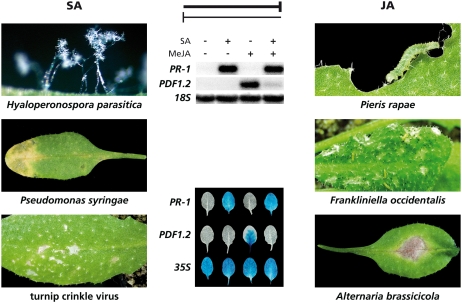Figure 1.
Schematic representation of mutually antagonistic cross talk between SA- and JA-dependent defense-signaling pathways in Arabidopsis. SA-mediated defenses are predominantly effective against biotrophic pathogens, such as H. parasitica, P. syringae, and Turnip crinkle virus, whereas JA-mediated defenses are primarily effective against herbivorous insects, such as P. rapae caterpillars and thrips (Frankliniella occidentalis), and against necrotrophic pathogens, such as A. brassicicola. Cross talk between SA and JA signaling is typically visualized by monitoring the expression of SA-responsive genes, such as PR-1, and JA-responsive genes, such as PDF1.2. In the middle of the figure, a pharmacological experiment is shown in which exogenous application of 1 mm SA to the leaves of wild-type Arabidopsis Col-0 plants resulted in the accumulation of PR-1 mRNA and activation of the PR-1 promoter that is fused to the GUS reporter gene. Application of 100 μm MeJA resulted in the accumulation of PDF1.2 mRNA and the activation of the PDF1.2 promoter that is fused to the GUS reporter gene. The combined treatment with SA and MeJA resulted in strong SA-mediated suppression of the JA-responsive PDF1.2 gene, thereby exemplifying the antagonistic effect of SA on JA signaling. Depending on the plant-attacker interaction, SA/JA cross talk has been demonstrated in both directions. Photos: Hans van Pelt.

